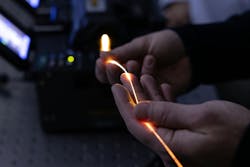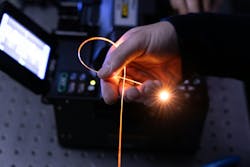Relativity Networks launches next-gen hollow-core fiber
Laser Focus World: Can you introduce us to Relativity Networks?
Jason Eichenholz: Relativity Networks is a next-gen hollow-core fiber (HCF) provider that increases the speed of data transmission in fiber optics. By replacing glass with air, we created technology to move data nearly 50% faster and farther to address the growing demands of data centers and their enormous power requirements.
HCF moves data faster with lower latency—less delay—than conventional fiber. This enables data to travel 1.5x farther without impacting the latency that can throw intricate multilocation data operations and applications out of sync. While traditional fiber-optic cables typically limit data centers to within 60 kilometers (37 miles) of each other due to latency constraints, our HCF technology extends this range to 90 kilometers (56 miles). Increased geographic flexibility allows organizations to strategically position their data centers closer to existing and emerging power sources.
LFW: How is the company differentiating itself?
Eichenholz: In a world in which data centers can’t afford downtime, HCF offers a superior transmission medium. It reduces errors in link while extending the distance of latency domains, which makes it the ideal solution for the demands of the cloud computing and AI era. Our proprietary antiresonant fiber designs create an advanced optical waveguide made of precision-engineered glass walls so thin they are invisible to the human eye. These structures create mirror-like boundaries that confine light and guide it through an air core with unmatched speed and minimal power loss.
But it makes HCF more complicated to manufacture compared to solid-core fibers—it requires several antiresonant structures for optimal confinement of light. The design is complex because many parameters determine their optical performance and manufacturability. Advanced, bespoke simulation software verified with experiments allows Relativity Networks to quickly iterate new HCF designs to create a fiber that produces superior performance with lower attenuation, lower dispersion, higher-power handling with lower nonlinear impairments.
Relativity Networks is focused on commercializing HCF technology through strategic partnerships, such as our recently announced partnership with Prysmian. This collaboration will see Prysmian and Relativity Networks co-manufacture fiber and cable based on our HCF technology, which was developed in collaboration with the College of Optics and Photonics at the University of Central Florida. We believe our antiresonant fiber designs are conducive to high-volume manufacturing. And our innovation mindset is bringing together the right companies to scale production rapidly—ensuring there will be enough supply to support fiber deployments at the pace AI’s growth demands. Our solution has proven it can address the growing needs of the digital economy, and we are bringing the industry together to support that growth.
LFW: Long-term goals?
Eichenholz: We’re reshaping the architecture of the optical network. By guiding light through air instead of glass, HCF reduces signal distortion to enable faster, farther data transmission. This unlocks new network design possibilities and supports the push to terabit-scale communications and beyond—and solves today’s data center power crisis.
By doing so, we’ve already secured multimillion-dollar contracts and deployed our technology within several U.S. field installations—marking an important step in our growth trajectory. Now we’re focused on bringing in the right partners to scale to high-volume production rapidly and ensure we can support widespread deployment of this transformative technology so there’s enough supply to support the entire industry. Having the ability to manufacture fiber and quickly iterate on designs using Relativity Networks’ simulation tools is like having many blank canvases. We’re no longer restricted to wavelengths and power limits associated with glass single-mode fiber (SMF). This opens up new wavelengths and operating bands.
The networks part of our business relates to designing new optical transceivers at new wavelengths with high-power optical amplifiers to take advantage of the superior transmission performance of our HCF. We’re partnering with key players within the industry to build an ecosystem of new transmission systems addressing the capacity needs of tomorrow’s data center optical network.
LFW: Any manufacturing challenges for HCF cables?
Eichenholz: Relativity Networks’ HCF cables are more expensive than traditional fibers, which have not fundamentally changed for more than 40 years. But we aren’t just selling fiber cables; we’re selling time. More data transferred in less time equates to these companies—who are already spending billions of dollars on fiber cables—seeing immediate value in this offering. So while the upfront cost is higher, the return on investment is insurmountable.
LFW: Any surprises involved in getting a HCF company launched?
Eichenholz: With growing urgency, major cloud-computing providers and their clients must confront a critical challenge: How do you meet the insatiable demand for new data centers—and the electrical power they require—to handle the massive data-processing needs of the AI era?
The power problem is currently the biggest impediment to the future of the AI-driven economy. To overcome this challenge, some of the largest cloud-computing companies are now turning to HCF. I knew I had to be part of this change. After all, my motto is “Why not change the world?”
I learned about Rodrigo Amezcua Correa’s HCF technology from my alma mater, The College of Optics & Photonics at University of Central Florida. Seeing his research transported me back to a paper I’d written 20 years prior about next-generation fiber technology. Back then, it was just a concept. Today, it’s a much-needed reality.
HCF can provide the high-speed and high-bandwidth communications pathways that AI and other computing-intensive applications now require. But, even more importantly, HCF can go a long way toward helping meet the extensive energy demands of the data centers that will power the AI age.
40% of data centers could face constraints in power availability by 2027 as AI demand continues to ramp up, according to research from Gartner. And McKinsey estimates that global demand for data center energy capacity could rise by 20% or more a year through 2030, with the additional annual demand exceeding 200 gigawatts—which is enough to power 160 million U.S. homes.
Unless something changes, new data centers can’t be built fast enough to fuel the rapidly expanding AI-driven economy. But HCF can be that change agent.
LFW: How does your HCF enable data centers, AI, and quantum computing to take off? Any other applications you’re targeting?
Eichenholz: There is an insatiable demand for data centers to handle the massive data processing needs of the AI era. The power problem is currently the biggest impediment to the future of the AI-driven economy. This is where our technology comes into play—we support the high-speed and high-bandwidth communications pathways that AI and other computing-intensive applications now require.
We serve multiple high-performance sectors, such as cloud-computing hyperscalers seeking to expand their data center footprint, telecommunications providers preparing for next-generation networks, healthcare and pharma organizations that need access to faster data, and 5G infrastructure companies aiming to build future-ready networks. Relativity Networks enables hyperscalers to build facilities where power is available—opening up a 2.25x geographic area for data center selection.
While we are also fielding inquiries from customers about future markets such as quantum communications and high-power lasers for directed energy, we’re laser focused on telecommunications for data centers and 5G.
LFW: Most intriguing HCF trends you’re seeing emerge?
Eichenholz: HCF represents the next revolution in optical networking and offers unprecedented speeds and lower latency that traditional fiber simply cannot match. A key emerging trend is their growing role for AI infrastructure, particularly within data centers. New data centers can’t currently be built fast enough to satisfy the rapidly expanding AI-driven economy, and the lack of available power is an existential threat to fueling that growth. AI will drive an expected 165% increase in data center power demand by 2030. With HCF’s lower latency characteristics, the technology reduces signal distortion and enables faster, farther data transmission for AI servers.
Further, HCF represents a breakthrough for quantum computing by minimizing the decoherence that typically occurs through light-material interactions. This unique architecture helps preserve delicate quantum states for longer periods, which makes it a promising solution for advancing quantum operations and improving gate fidelity.
Years ago, I wrote about how photonic-crystal-fiber technology promises to yield better ways to guide light. And now we’re applying that concept to data. Back then we knew that HCF could transmit power in more beneficial ways; now we’re putting it to practice.
Ultimately, HCF is a solution that stands ready to meet the growing needs of the digital economy.
About Jason Eichenholz: He’s the cofounder and CEO of Relativity Networks and a pioneer of laser- and optics-enabled innovation, product development, and commercialization. He holds a Ph.D. in optical sciences and engineering, as well as more than 90 patents within the field. Eichenholz co-founded Luminar, a leading provider of LiDAR. In 2023, he co-founded Relativity Networks.


